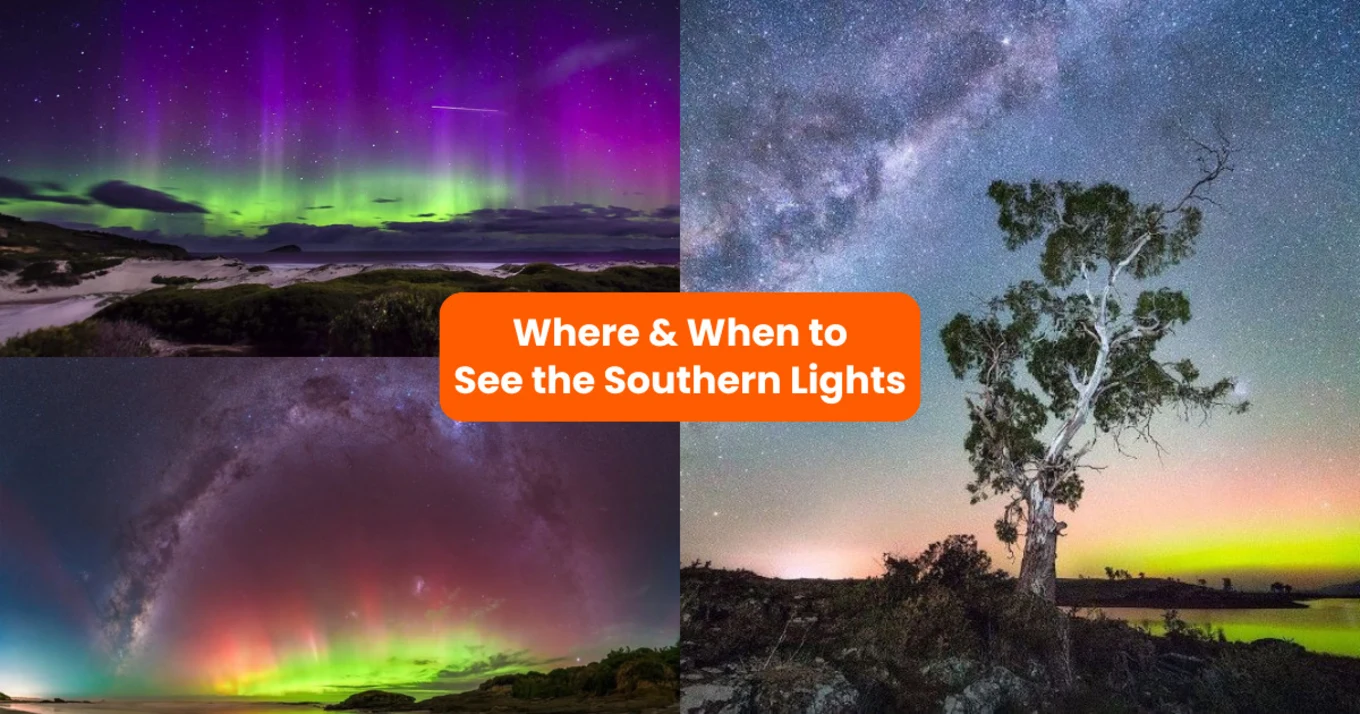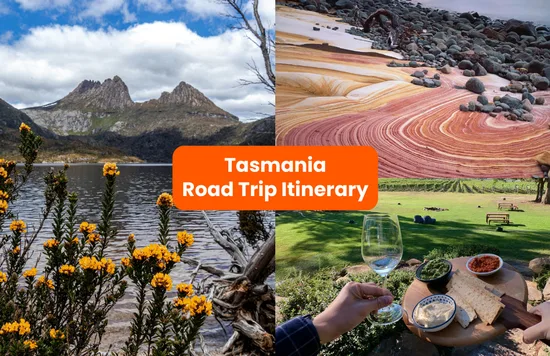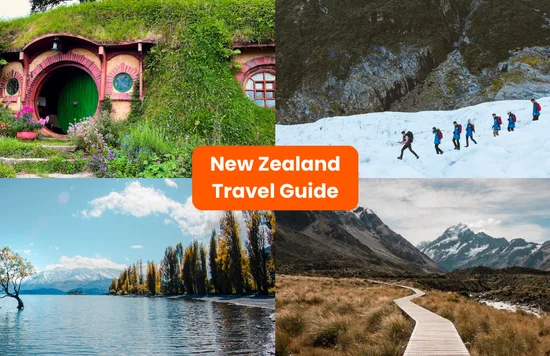Discover the Best Spots: Where to See Southern Lights in Spectacular Clarity
Are you on the quest to discover where to see Southern Lights? According to Dr. Jason Steffen, an associate professor of physics at the University of Nevada, Las Vegas, understanding the southern lights involves exploring the intricate dance of solar particles and Earth's magnetic field.
This concise guide locates the best spots for majestic views of Aurora australis. Unveil the secrets of Tasmania, New Zealand, and Patagonia as we detail how the geography of these regions makes them perfect for southern lights sightings!
What are the Southern Lights?
- The southern lights, or aurora australis, offer a breathtaking spectacle best viewed during the southern hemisphere’s winter months from March to September, ideally between 10 pm and 2 am in locations with minimal light pollution.
- Prime spots for witnessing the southern lights include Tasmania’s national parks and beaches, New Zealand’s southern regions such as Queenstown and Stewart Island, and the remote wilderness of Patagonia, each offering their own unique and stunning backdrops.
- For those seeking to capture the ethereal beauty of the aurora australis, it’s essential to use the correct photography techniques and equipment, including manual settings, a sturdy tripod, and high ISO settings, while also staying warm and prepared for the conditions.
Prime Viewing Times Across the Southern Hemisphere
Witnessing the full majesty of the southern lights hinges on perfect timing. The ideal window for this astronomical journey stretches from March to September. Imagine the excitement of observing the southern lights in various locales.
- Tasmania’s cool air from May to August, coupled with spring’s awakening in September, sets an awe-inspiring backdrop.
- New Zealand calls to aurora chasers between April and September with its unspoiled scenery as a picturesque stage for this celestial event.
- Patagonia embraces you into its pitch-dark embrace during May and July, enhancing the ethereal waltz of aurora australis.
The phenomenon occurs when charged particles from the sun interact with Earth's magnetic field, directing them towards the poles and creating the mesmerizing glow known as the aurora.
These periods are more than mere dates. They are open invitations into nocturnal splendour that await those who seek it. As winter descends upon the southern hemisphere, it transforms night skies into an exhibition of astral magnificence where the aurora australis performs memorably overhead.
#KlookTip: Take note though that Tasmanian auroras shine brightest between 10 pm and 2 am – these hours offer peak visibility for intrepid explorers delving into twilight’s depths.
Dreamy Destinations for Aurora Australis Admirers
To fully experience the southern lights, the southern hemisphere counterpart to the northern lights, one must travel to areas free from city light pollution. These phenomena serve as the counterpart in the southern hemisphere to what are known as northern auroras. Experienced seekers of this phenomenon frequently head towards New Zealand’s South Island, Tasmania’s untamed regions, or South America’s rough landscapes where they can observe the beauty of this celestial display that characterizes the southern skies.
The allure of each location is magnified by its distinctive topography and broad views across their respective horizons, providing an even more enchanting backdrop for viewing Aurora Australis.
Tasmania's Enchanting Night Sky
The enchanting island of Tasmania boasts a range of splendid sites suited for observing the southern lights, including:
- The elevated vista from kunanyi/Mount Wellington’s peak
- The peaceful edges of Bellerive Beach
- Bruny Island’s dramatic shorelines
- Carlton Beach and Goat Bluff
- Cradle Mountain-Lake St Clair National Park’s wilderness
Near the magnetic poles, these scenic locales offer an opportunity to witness not only the mesmerizing charm unique to the southern lights, but occasionally also give glimpses into its northern counterpart. These spots provide a captivating setting that magnifies this celestial spectacle.
For those seeking seclusion, Bathurst Harbour offers an isolated experience under the starry firmament. In contrast, in Tasmania’s Central Highlands — often referred to as ‘Land of a Thousand Lakes’ — expansive plains deliver unencumbered vistas ideal for aurora enthusiasts who desire wide-open views. Adventure-seekers can find novel vantage points around Highland Lakes or Braddons Lookout and along Dove Lake shores. Aurally aware adventurers frequent south-facing bays like those on South Arm Peninsula and other less populated areas away from city lights for more secret viewings.
New Zealand's Southern Light Spectacle
New Zealand’s picturesque settings act as the perfect backdrop for the enchanting display of the southern lights. The town of Queenstown, known not only for its thrill-seeking adventures but also as a prime spot for stargazers, offers night skies that are often painted with the captivating colors of aurora australis. Exploration leads to Stewart Island and Dunedin, each promising unique vantage points from which to witness this celestial spectacle.
As one travels deeper into New Zealand’s southern reaches, more astronomical wonders reveal themselves. There is an increased intensity in the vibrancy of the southern lights that greets those who search for its splendor at Earth’s remote extremes. The closer proximity to the magnetic south pole enhances encounters with aurora australis due to shifts caused by Earth's magnetic field, creating unforgettable moments. Approaching closer to the pole enhances encounters with aurora australis due to shifts caused by Earth’s magnetic field — forging unforgettable moments that resonate well beyond your visit.
Patagonia's Pristine Skies
Spanning across both Chile and Argentina, Patagonia stands as a bastion of the wild, its untamed essence complemented by the dazzling performance of the southern lights. Amidst this realm of sharp peaks and deep blue glacial waters unfolds the aurora australis, weaving an ethereal tapestry in the night sky. The optimal moments to witness this natural marvel occur during those stretches when nights are longest – times when daylight yields to enduring darkness close to the south pole.
Although there aren’t specific well-known sites for viewing within Patagonia’s expansive wilderness, its diverse terrain offers countless perspectives from which one might catch sight of these elusive nocturnal colors. Success hinges on finding an evening suffused with darkness—free from moonlight’s competition or cloud cover—that allows unfettered viewing. With some perseverance alongside favorable conditions, viewers can experience Patagonia’s southern lights, painting their silent poetry amidst celestial canvases illuminated in radiant hues.
Luxurious Lodgings with Luminous Views
For those in pursuit of the celestial dance known as the southern lights, Pedder Wilderness Lodge on Tasmania is an idyllic spot that offers:
- Clear views of the night sky displaying the magnificent light show.
- A view oriented towards the south with minimal interference from artificial lighting.
- Seclusion which greatly increases chances to witness a breathtaking aurora occurrence.
Staying at these lodgings increases your chances of seeing the southern lights, as they offer clear views and minimal light pollution.
Considering each appearance of these lights is singular and unpredictable, guests are encouraged to stay several nights for optimal viewing opportunities.
Meanwhile, Satellite Island shines as a sumptuous getaway deep within Tasmanian nature. It’s reserved for avid astronomers and lovers of natural splendour. There, one doesn’t merely observe. Instead, they become enveloped by a scene where every evening provides potential access to watch this spectacle unfold. In kindred spirit, but located Away lies South Georgia Island – another venue promising awe-inspiring encounters with pristine skies illuminated by ethereal glows.
Your Guide to Photographing the Aurora Australis
Capturing the essence of the southern lights requires adeptness with specific photographic equipment and techniques. When setting out to photograph the aurora australis, photographers should utilize:
- Precision through manual focusing
- Fast shutter speeds
- Wide apertures
- High ISO settings for sufficient light capture during night conditions
Experimenting with various photography techniques like photo stacking or creating time-lapse sequences can enhance your visual portrayal of this celestial event. Employ a wide-angle lens to capture an expansive view of the night sky so that every subtle ray is included in your shot.
For those moments when you’re capturing nature’s nocturnal ballet, it’s critical to have a solid tripod to eliminate any shake caused by excitement. Scouting your chosen location while there is still daylight will help in determining where best to compose your nighttime tableau. Ensure proper insulation against harsh weather, equip yourself with a headlamp for visibility and navigation after dark, and always carry extra batteries as they deplete quickly in cold temperatures.
Beyond the Lights: Nighttime Adventures in the Southern Hemisphere
Pursuing the southern lights offers an experience that transcends just stargazing. At Bruny Island in Tasmania, when night falls, it brings with it more than astronomical spectacles—it becomes a portal to unique wildlife encounters. Here you can witness the majestic flight of wedge-tailed eagles and spot the elusive white wallaby.
As anticipation builds for the night sky to reveal its enchanting display, the surrounding terrain is alive with its own form of nighttime dance teeming with creatures great and small.
Preparing for Your Aurora Chasing Journey
Embarking on a pursuit of the aurora australis is an excursion into terra incognita, where thorough planning navigates your course. Engage with community groups such as Aurora Australis Tasmania on Facebook to gain access to shared knowledge from experienced chasers who post real-time forecasts and essential advice.
Proper attire involves layering: start with thermal clothing, add insulation, and top it off with waterproof gear to shield yourself against nature’s capricious elements. Remember also to bring along swimwear — after immersing yourself in the celestial display for an evening, relaxing in the soothing warmth of hot springs could offer the perfect sanctuary.
Insider Tips from Seasoned Aurora Chasers
To enhance your chances of experiencing the southern lights, heed the advice from those who have been captivated by the aurora. Applications such as Glendale and live updates via platforms like Aurora Alerts UK on Telegram can shift your pursuit from wishful to successful. Embrace patience and perseverance if you aspire to be a dedicated aurora hunter. While clear skies are not guaranteed, when they align, the spectacle is otherworldly.
For an unobstructed view of this natural marvel, it’s crucial to find locations with pristine southern skies away from urban illumination. Stay informed about solar dynamics that ignite both aurora australis and aurora borealis through resources like the Aurora Forecast app and SpaceWeather Live. For fellowship and regular updates, connect with communities such as the Aurora Australis NZ Facebook Group, which provides daily insights and shared enthusiasm among aficionados.
Frequently Asked Questions
What are the best months to see the southern lights in Tasmania?
May to August are the prime months for observing the southern lights in Tasmania, with a heightened chance also around the September equinox.
To maximize your opportunity to behold this natural spectacle, plan your experience during these periods.
Can I see the southern lights from New Zealand?
Indeed, the southern lights are visible from New Zealand’s South Island, particularly between April and September.
Take in the breathtaking vistas!
Are there any special techniques for photographing the aurora australis?
In order to take breathtaking images of the aurora australis, it’s advisable to employ techniques such as manual focusing, quick shutter speeds, wide apertures, elevated ISO values and also try out methods like photo stacking and creating time-lapses for more impressive results.
Wishing you success in your photographic endeavors!
Where can I get real-time updates and tips for aurora chasing?
For those keen on pursuing the shimmering spectacle of auroras, joining community Facebook groups can be an invaluable resource for live updates and guidance. Leveraging tools such as the Glendale app or subscribing to Aurora Alerts UK on Telegram will enhance your chances of witnessing this natural phenomenon.
Enjoy your pursuit!
What is Klook?
Klook is Asia’s leading platform for experiences and travel services. We curate quality experiences ranging from attractions and tours to local transport and experiential stays, in over 2,700 destinations globally.
Browse our growing collection of travel activities and services in 15 languages, and complete bookings seamlessly with 40 currencies and over 40 payment methods.
Founded in 2014, we are here to inspire and enable more moments of joy for travelers anytime, anywhere. Whether it's something new in your neighborhood or an adventure abroad, with Klook you're always connected to a world of things to do and places to see.




























